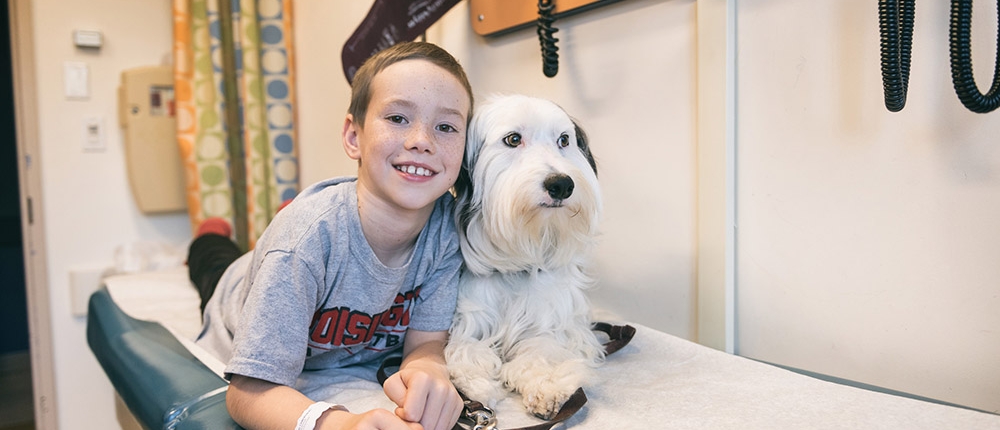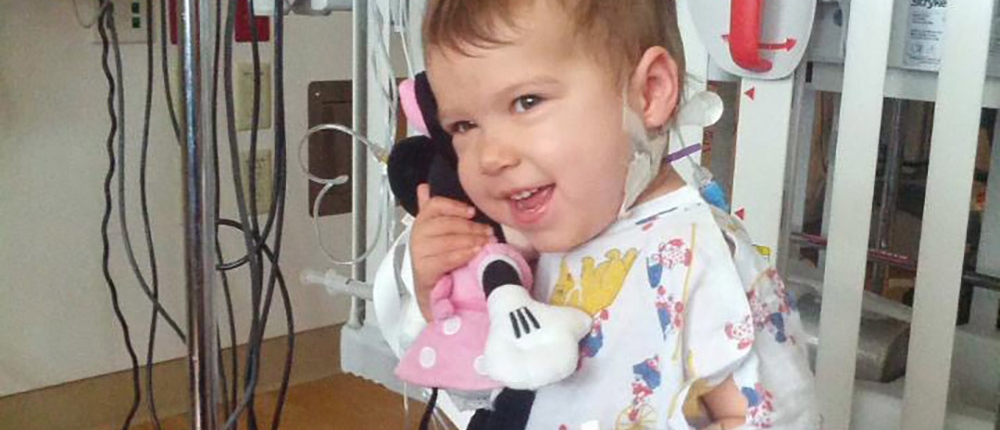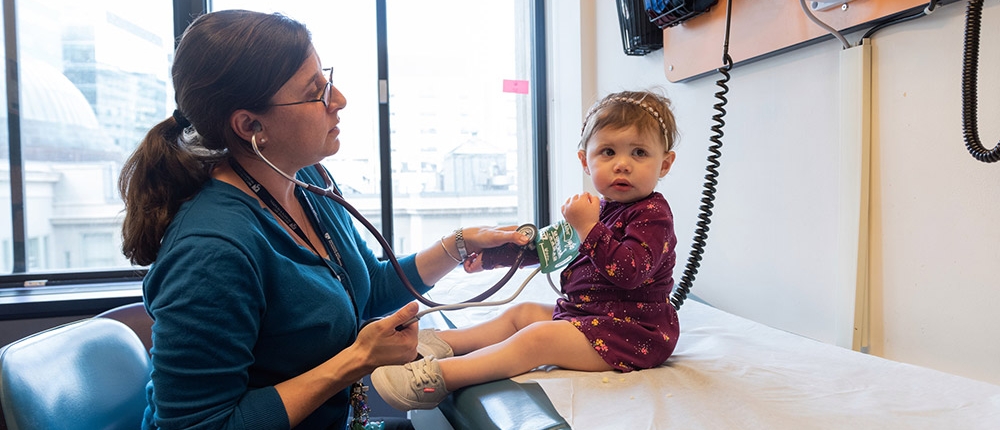Questions & Answers
Below are some questions and answers related to midaortic syndrome and pediatric renovascular hypertension diagnosis, as well as a list of questions to ask your health care provider.
Questions & Answers
Below are some questions and answers related to midaortic syndrome and pediatric renovascular hypertension diagnosis, as well as a list of questions to ask your health care provider.
What is renovascular hypertension?
Renovascular hypertension is high blood pressure that results from an abnormally small, narrowed or blocked, blood vessel supplying one or both kidneys (aortic or renal artery narrowings). This vessel may be the main kidney blood vessel, or any of its branches.
What is midaortic syndrome?
Midaortic syndrome is not a diagnosis, but rather a term used to describe a narrowing of the abdominal aorta, the blood vessel that carries blood from the heart to the rest of the body, and very often other blood vessels are involved, including those that bring blood to the kidneys and intestines. Children with midaortic syndrome very often have high blood pressure, and some children can have rather long aortic narrowings that extend into the chest (thoracic aorta).
What is a normal blood pressure for my child?
What is normal depends on your child’s age and size. Your doctor should tell you what range of blood pressure is concerning. Learn more
How high is too high for blood pressure? When should my child be brought to the hospital if his/her blood pressure spikes?
Symptoms of very high blood pressure can include headache, changes in vision (ability to see), or irritability. Some children have trouble growing, and some may have pain or fatigue in their legs when they try to exercise. Many children do not have symptoms even if their blood pressure is very high. Specific guidelines about when to seek medical attention for blood pressure spikes should be provided by your doctors.
Will my child need surgery?
Many children will require surgery or some other intervention. Many factors may determine the timing of intervention, including the severity of the blood pressure elevation, the presence of symptoms, the age and size of the child, and whether or not the child has experienced complications such as heart changes or decreased kidney function. It is important to remember that treatment with medications alone is appropriate in some children.
Can my child live a normal life? Does my child have any limitations/restrictions? Will this affect my child academically?
The goal of any intervention or therapy is to help your child live as well as possible. Since every child is different, your doctor will need to help determine if your child needs any restrictions. Some children with midaortic syndrome or an associated syndrome like NF-1 do have learning difficulties or other developmental delays, but it is impossible to know if the midaortic syndrome is the cause.
Was my child born with this condition or did it develop over time? How rare is this disease?
Some children are born with renovascular hypertension and midoartic syndrome, while others may develop this over time. Children with associated conditions, like Neurofibromatosis Type 1 and diseases that cause inflammation of the blood vessels (Takayasu’s arteritis), are more likely to have changes in their condition over time, meaning that they may develop worsening disease as they grow.
This is a very rare disease, and we do not know exactly how many children are affected.
What Comes Next?
What are the most critical signs to look out for?
Unless the blood pressure elevation is very severe, many children have minimal or no symptoms from high blood pressure. Symptoms may vary depending on the blood vessels involved, and may also be related to complications of therapy. It is best to ask your specific provider for guidance before and after any interventions. Critical symptoms to look out for may include: excessive sleepiness or fatigue, recurrent headaches, changes in vision, or seizures.
Once a child is diagnosed with renovascular hypertension, it is very important that a system for blood pressure monitoring and surveillance of the kidneys are developed with the doctors involved in the child’s care.
Which doctors and specialists should my child see?
It is important to have a team approach after a diagnosis of renovascular hypertension or midaortic syndrome are made. The team may include doctors that specialize in kidneys (nephrologists), the heart (cardiologists), surgeons, and interventional doctors who may use approaches besides surgery to address narrow blood vessels. Some children may require additional care from specialists like a brain doctor (neurologist), brain surgery doctor (neurosurgeon), and/or a doctor who evaluates inflammation that affects blood vessels (rheumatologist).
Medical Management
What does medical management mean? Does it really work?
Medical management is part of the treatment for nearly every child with renovascular hypertension, including midaortic syndrome. This means using medications to treat blood pressure. Even if a child has surgery, many will still need medicine after surgery to treat blood pressure.
What are the most common blood pressure medicines to treat this condition? What are the side effects of each medication?
There are several types of medication used to treat high blood pressure. Your doctors will choose the best medications, which may vary depending on the situation. Most children will require more than one type of blood pressure medication. Remember that side effects from blood pressure medications are reversible, so if your child develops a side effect, you should discuss that with your doctor.
How do I properly take my child’s blood pressure? Is there a machine that works better than others?
Most blood pressure machines available in drug stores or online are designed for adults. Your child will need one that is approved for use in children, and that comes with a cuff that will fit their arm. You can look up a list of devices approved for use in children at www.stridebp.org. You may need to talk to your child’s medical team to get a cuff that will fit their arm, especially if they are quite young. They may also have a designated supplier and may be able to provide in-person training and/or demonstration..
How long does medical management last before a child needs surgery?
Every child with renovascular hypertension is different. Some children can be treated with medications alone, and not require surgery. Some children will need surgery or other treatment , which may or may not resolve high blood pressure (ie: some children will still require medications for blood pressure despite a successful surgery or intervention).
How do you know when medical management is failing? What are the signs to look for?
Using medicines to lower blood pressure is one part of treating renovascular hypertension. Your team also needs to be watching for any issues that could affect organs that have lower blood flow from the renal artery narrowing or midaortic syndrome. For example, some children will have a lack of kidney growth, which is abnormal, and in such a case, even if the blood pressure can be controlled with medicine, an intervention may be needed. In other children, the blood pressure may still be too high even when the child is given multiple types of medication. Other children may develop symptoms from the midaortic syndrome like leg pain or abdominal pain after eating. These symptoms are rare, but require surgery for treatment.
Surgery
What types of surgeries/interventions are available?
There are many types of surgeries and other catheter-directed treatment options available to address renovascular hypertension, including midaortic syndrome. Since every child is different, it is important to review what is best for YOUR child with your team.
What are the different types of surgical interventions and what determines which intervention is deemed best?
There are a few ways that narrow blood vessels can be addressed. In some cases, the narrowed or disease artery can be removed and the artery reimplanted onto normal artery or completely replaced (bypass) with another blood vessel or with artificial material. In some cases, surgeons may remove the kidney to repair the kidney artery, and then reimplant the kidney artery onto a different area of the aorta or pelvic artery (iliac), this is called a kidney ‘auto-transplant’. Sometimes doctors refer to “endovascular” techniques. This means that a tube (catheter) is placed inside the blood vessel, usually through a groin or arm artery. If the blood vessel is stretched using a special tube, this is called “angioplasty.”
What are the risks and complications of surgery and catheter-based treatments?
This is an important question to ask your team. Each surgery may have different risks, depending on what the goal of the surgery is as well as any other co-occurring medical problems (comorbidities) that may be present.
Post Surgery/Hospital Stay
How long do you expect our hospital stay to be?
Because each child is different, the length of stay will vary. Some endovascular procedures may be as little as one day, while some surgeries may require a hospital stay averaging 1-2 weeks or longer for complex cases.
What are the tubes you are placing in my child and what do they monitor?
Depending on the magnitude of the operation, your child may have one or more of the following:
- Foley/urinary catheter: a thin rubber tube inserted into the bladder for measuring the amount of urine being made by both kidneys
- Chest tube: a clear plastic tube placed in the chest to remove air from around the lungs so your child is able to take a full breath
- Arterial line (or “a line”): a special type of thin tube, similar in appearance to an IV, that allows for your child’s doctors to measure their blood pressure every second
- Central lines: thin catheters that enter the neck or groin to allow access to the large veins in the body so certain medications can be given without causing your child discomfort
- Nasogastric (or “NG tube”): a clear plastic tube that is placed in the nose and sits in the stomach to drain any food or liquids that may back up. This serves to protect the lungs after surgery.
What are the risks of being on medications, including opioids and sedatives?
The most common side effect of opioids is constipation, but each child responds differently. Some may become sleepy, while others can exhibit hyperactivity. Long term use of opioids can lead to addiction, even in children, so your doctors will work to wean them off quickly.
Anesthesia and other sedatives are generally safe in kids when used appropriately, and will be administered by physicians and nurses specifically trained in their use.
What happens when we go home? How often will we return for follow-up appointments?
Before you and your child leave the hospital, they will be assessed for any restrictions or special device needs at home by a team of therapists. In-person follow up will be determined before you leave the hospital, but is generally at one month, six months, and then yearly for continued surveillance of the repair..
When we go home after surgery, is there anything special we need to purchase for follow-up care at home?
This will be determined by your surgical team and the therapists evaluating your child. Some medical equipment (“durable medical equipment” or “DME”) is covered by insurance.
How do I order a blood pressure machine? Does insurance cover it?
Most blood pressure machines available in drug stores or online are designed for adults. Your child will need one that is approved for use in children, and that comes with a cuff that will fit their arm. You can look up a list of devices approved for use in children at www.stridebp.org. You may need to talk to your child’s medical team to get a cuff that will fit their arm, especially if they are quite young. They may also have a designated supplier.
Many insurance plans will cover the cost of medical equipment if you have a doctor’s order/prescription. Contact your child’s medical team for this.
General Questions
Can you explain lab values and the normal ranges? What is creatinine? H&H?
There are a number of laboratory tests that may be used to monitor a child with renovascular hypertension. Creatinine is a waste product that comes from muscles and passes into the urine. When the kidney function is impaired, the creatinine value rises and thus it can be used as a marker of kidney function. Normal creatinine values vary over the course of childhood with growth, and the laboratory result should provide a range based on age. Electrolytes are also typically assessed at regular intervals. These tests measure levels of different substances in the blood (sodium, potassium, bicarbonate). H&H refers to hemoglobin and hematocrit, which are tests to determine the level of red blood cells (oxygen carrying cells) and assess for anemia, or blood loss. Normal values vary with age and after adolescence by sex; this laboratory should also provide a normal range.
Whom do we call with an emergency?
You should clarify with your provider which member of the team to contact with concerns as some questions will be best answered by one member versus another. In case of emergency, you should always seek immediate care by (calling 911, or taking your child to the closest emergency room and asking them to contact your child’s team.) In less urgent situations, most medical groups will have an on-call provider. Please address this with your doctor’s practice to determine what their on-call procedures entail.
Questions To Ask Your Doctor
- Have you seen this diagnosis before in a child of my child’s age and size?
- Have you worked with any of the centers that specialize in this condition?
- Are you willing to collaborate with one of the centers that specializes in this condition?
- If the local team is proposing a surgical or catheter-based intervention, do they have experience with this intervention in children with this disease?






